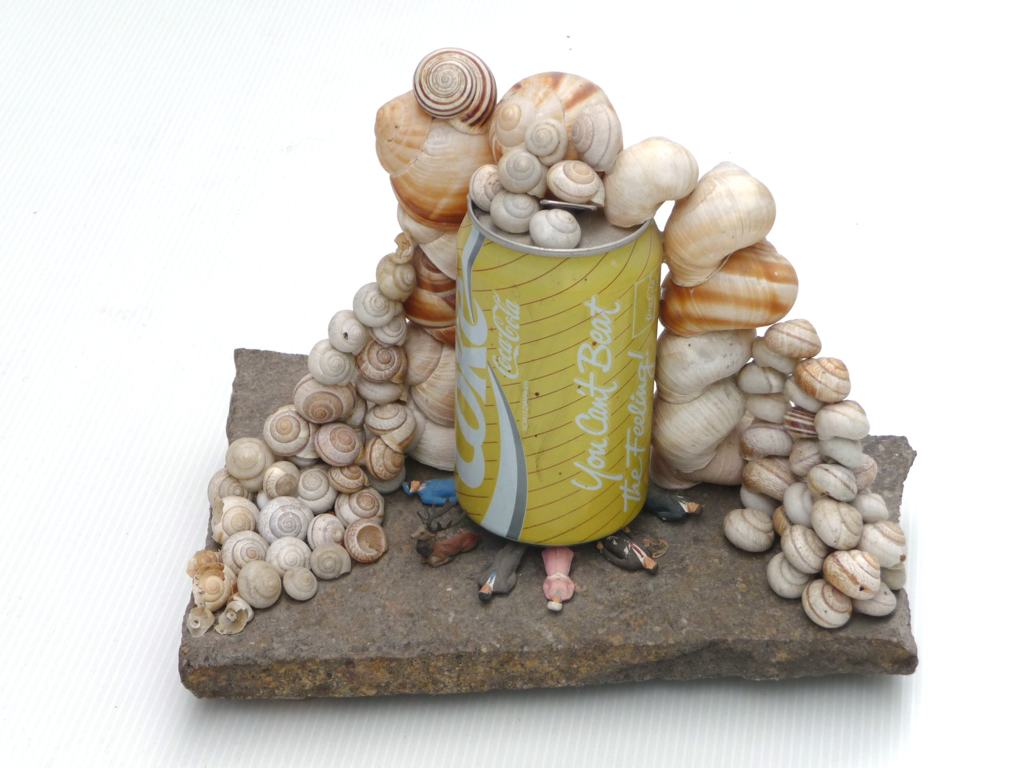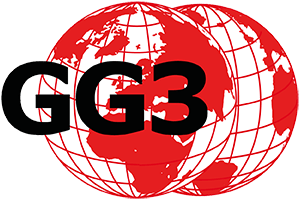A summary of the workshops, lectures, talks at GG3 and experiences by Tom Albrecht
As artists, we take responsibility for our own use of resources, we start to talk about our own use of resources in art. Motto: No art for a dead Planet. But art for a sustainable planet.

Cola snails. Tom Albrecht, 1990, Berlin, 24 x 24 x 17 cm, cola can, snail shells, model figures, stone.
How that works is still experimental. The artists are challenged to find out. We can use our innovative potential. We often do not yet know the one solution. But we are searching, working out ways in our workshops.
1
We are in the process, we compromise, we feel our way forward. This text is intended as a suggestion. We call on artists to share their experiences with us and to add them here.
Sustainable work
A sustainable (NH) work is a strong work for the artist*. He/she works in flow, is satisfied, takes a substantive position on the world, works on existential themes, picks up on NH themes, makes hidden things visible, enjoys looking at the work. The work creates resonance with the counterpart, is not didactic, does not raise the forefinger, is not moralistic, is aesthetically beautiful, has humor, irony, lightness.
For the counterpart(s): The work does not seem moralistic, condemning, it is mysterious, allows resonance, jumps, touches, has a lasting effect, idea and implementation are right, opens new perspective, causes reinterpretation.
Production constraint
can hinder sustainable work. Escaping from it in studies, through funding, with scholarships, in residencies e.g. in the Academy for Sufficiency. Does selling always have to be the goal? Being NH as an artist where it is possible, where conscience and finances allow it.
In free scene exhibitions take entrance fee for the artists, can detach from the compulsion to sell. Difficult in Berlin. Donation works. NH arts fund through party, crowdfunding, new formats like music and visual arts.
Art market
Criticize the unsustainable art market and produce as sustainably as possible themselves. The art world doesn’t pay attention to its resource consumption and doesn’t talk about it. But we! And we criticize that. The issue will become more important.
The freedom of art does not release the participants from their own responsibility to work for more sustainability.
Certificates
Use material with certificates. certificates are the “Blue Angel”, the “pfc mark” (Not “Mix”) for paper. These are more credible than the vague term “recycled paper.”
What would a “Sustainable Art” certificate look like? It should be transparent. Who awards it, what are the criteria?
Material
General
Which material is suitable also depends on the purpose, for example, the place of exhibition inside or outside.
If necessary, combine old material with new. For some things there are already proven answers, see below. These plants consume fewer resources, use renewable raw materials and end-of-life materials, and keep the ecological footprint small.
As an artist, consider the consumption of resources, ask yourself if it works with less material or natural. How does my work change with NH material?
Reduce material use
Use existing materials as in Arte Povera, from recyclables garbage cans, from the cemetery.
Take advantage of the season, for example, after Christmas there are needles, fir trees abundant on the street. Asking yourself if the idea needs to be realized immediately. Speed often costs resources.
In Berlin, obtain material from Kunststoffe e.V.. Visit the place in the House of Materiality and get inspired.
Maintaining the “collection of screws”, having fundus with system. What do you collect, what do you give to colleagues, what do you throw away? Collect only if it can also be stored or shared.
First consult your own stock, then visit Materialmafia / Kunststoff e.V., then go to the trade
Individual screws can be cheaper in the hardware store than bulk packs.
Design works so that materials are reusable. Store works so that they can be sold or re-exhibited or recycled.
There is a lack of a material pool with technical equipment for visual artists, e.g. spotlights, fog machines. Build and use material networks with colleagues, for small things close by, for big things through intermediaries, warehouses. Do not throw away anything is an ecological quality, if necessary, offer to the fund. Borrowing and lending works up to the individual limit on equipment. Depends on trust and physical proximity.
Material aging, store well, care for. Use old clothes as rags, for example. Take paper napkins with you when you eat. Have courage to save food, bring vessels for it.
Make compromises
If we want to use certain techniques, we have to make compromises for some projects. For example, the printing material PLA for 3D printing is not yet easily recyclable. Also we need electrical machines for the printer. Here, however, it is worthwhile to observe the development towards more sustainability and to participate in it if there are solutions.
As committed people, we can only endure if we cannot reduce the consumption of resources in our work. Some tools, materials can not be avoided. We weigh our concept, the costs, the benefits and our patience.
Where are my priorities in production, sales and sustainability?
New works
Do we work from the idea or from the material? Using existing material is more sustainable than buying new.
Ephemeral art
can be more sustainable. From living natural materials it becomes permanent by documenting and certificates.
Painting
Color
Prepare ink quantity according to planned consumption
Oil paint: Wash brushes without solvent, but first with sunflower oil, then with gall soap. Is also health protection.
Avoid pigments containing heavy metals such as lead, cadmium. Ask sales staff for alternatives.
Alternatives to organic volatile solvents are egg tempera, gouache
Real hair brush
Hair harvesting is animal cruelty or profits from unsustainable meat consumption.
Canvas
Cotton consumes a lot of water. Nettle and linen can be an alternative.2
Occupational safety and health
Painting oil and acrylic paints with latex gloves, put on cotton gloves underneath. No protection is needed for watercolor.
Waste
Avoid: Generate less waste. Use things up, store well
Disposal: Put waste without heavy metal (SM) and solvent (LM) into the residual waste, with SM and LM into the hazardous waste at the city cleaning. Allow solvent to dry out in residual waste. Empty packaging in yellow garbage can.
Waste water
Paint residues containing acrylic, microlastic and organic solvents such as turpentine do not belong in wastewater.
Allow to dry in with aeration, then place in residual waste.
Still liquid: hazardous waste
Clean brush with brush cleaner under water is ok though. Brush e.g. in old cloth pre-clean to load waste water less.
Require written rules from training sites and workshops as to what may or may not be discharged into wastewater and where the appropriate waste or even hazardous waste containers are located.
Stone
Recycle sculptures from abandoned tombstones, for example, instead of using new marble. Use stone scraps.
Packing
Reuse, use renewable raw materials, use old materials
Events
No disposable tableware, organic drinks and food if possible, vegetarian-vegan, regional
Travel
Meeting each other is important, building and maintaining contacts, but traveling consumes resources. When is the physical encounter important, when is the online conference or chat enough?
Form and use network
https://kunst-stoffe-berlin.de/,“Kunst-Stoffe promotes creative engagement with reuse and re-purposing strategies. Leftover and used materials are tapped as sustainable resources in our collection centers and given away inexpensively to artists, do-it-yourselfers, and nonprofits.”
https://galleryclimatecoalition.org/
For Gallery Members, Artist Members, Individual Members, Organization Members
The goal of the GCC is to facilitate the decarbonization of the visual arts sector and promote zero-waste practices. For example, they offer an online carbon calculator to determine the carbon footprint for the institution. The offer also includes an exchange, for example, for the reuse of transport packaging from factories.
Artists in Nature International
Raise images
Use MDF instead of kapa (plastic made from fossil raw material).
When can Aludibond (aluminum is energy-intensive and recycling problematic) be replaced by MDF or cardboard? Pressboard? Mount photo or poster on MDF or canvas.
Mat. reuse and print overleaf. Who has experience?
Save energy
Internet
Maybe a city map on paper instead of maps, offline maps on the smartphone, books instead of the Internet, Ecosia as a search engine will do the trick.
Order your own website from provider with real green power. Reduce image files before uploading.
Work offline when web is not necessary.
Privacy: Use cloud in EU. Use devices and software independently from USA companies. Alternatives to Adobe: Image with GIMP, Affinity, Apple: 3D Blender
Videos
As a media artist, be aware of the ecological side of the work.
Video portals maintain large server farms that consume power and cooling. Therefore set resolution and bitrate only as much as necessary, Vimeo standard is enough for online display. 4K – use resolution only offline, HD quality 1920 x 1080 px or less to 1280 x 720 px, compression rate 8 – 10 Mbit/sec, frame rate 25 (EU) – 30 (US) frames/sec.
Audio see podcasts
Podcasts
Normalize volume, variable compression rate e.g. 9.45 – 48 kBit/sec, as small as possible, mono if possible, set sample rate from 44kHz to 22 kHz.
Put photos online
Desktop: Website 1024 to 1200 pix for longest page, quality 60 to 80%, jepeg format, prevents theft for print; for logo, graphic, icon use PNG.
Instagram, Facebook
Compress images, smartphone: app. use for compressing, settings as for desktop
Online Archive
Online archive with website: Are they replacing print catalogs? Are they more resource-efficient?
Operate cloud archive in a data-saving way, store raw video offline
Own website
Delete plugins that are not needed: Link to external websites instead of embedding saves energy.
Office
delete old mails, e.g. set automatic deletion after a certain number.
Electricity and heating
Shock instead of continuous ventilation of the studio during the heating period. Turn off lights when leaving the room. LED light bulbs save the most. Often in existing lamps incandescent, fluorescent lamps can be replaced with LED.
Working in daylight can be part of the concept.
NTFs
Selling a crypto artwork consumes as much energy as the studio uses in two years. Now, artist Joanie Lemercier is committed to reducing the carbon emissions of this medium.
Text (C) Tom Albrecht based on: workshops and lecture in GG3 exhibitions: 4/18/2013 “To Buy or Not to Buy”, 11/2/2019 “Artists for Future”, 7/20/2020 “Fossil Addiction”, 9/17/2021“Commentary on the Present”, 11/26/2021 “Endless Summer”.
If you benefit from our work, please mention us on your site and link to us.
